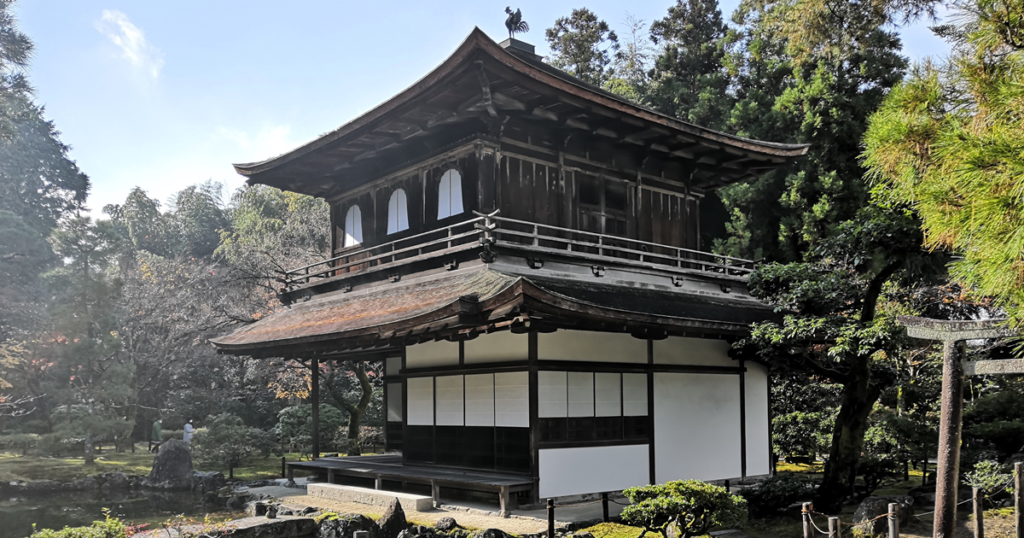Kyoto – Ginkakuji / Higashiyama Jisho-ji.
Ginkaku-ji Temple(officially named Higashiyama Jisho-ji), which has the Jisho-ji Garden, which symbolizes Higashiyama culture in the Muromachi period, was originally built as a mountain villa by Ashikaga Yoshimasa, who retired the eighth shogun of the Muromachi Shogunate.
After the death of Yoshimasa, that mountain villa was changed to a Zen temple to mourn for Yoshimasa’s soul, and the name of the temple was changed to Jisho-zenji after Yoshimasa’s title of respect “Jisho-inden”.
The mountain name is Higashiyama, and the principal image is Shaka-Nyorai, and it is one of the sub-temples of the Rinzai Zen Shokokuji sect.
On December 17, 1994, it was registered as a UNESCO World Heritage Site as part of the “Historic Monuments of Ancient Kyoto (Kyoto, Uji and Otsu Cities)” along with 17 temples, shrines, and castles such as Kinkakuji, Kiyomizudera, and Nijo-jo Castle. [reference] UNESCO World Heritage Convention.
The UNESCO World Heritage Site “Historic Monuments of Ancient Kyoto (Kyoto, Uji and Otsu Cities)” is a list of 17 temples, shrines, and castles in Kyoto City, Uji City, Kyoto Prefecture, and Otsu City, Shiga Prefecture, registered as properties 688.
Kamowakeikazuchi Shrine (Kamigamo Shrine) -Kyoto City.
Kamomioya Shrine (Shimogamo Shrine) -Kyoto City.
Kyoogokoku-ji Temple (Toji Temple) -Kyoto City.
Kiyomizu-dera Temple -Kyoto City.
Enryaku-ji Temple -Otsu City.
Daigo-ji Temple -Kyoto City.
Ninna-ji Temple -Kyoto City.
Byodo-in Temple -Uji City.
Ujigami Shrine -Uji City.
Kozan-ji Temple -Kyoto City.
Saiho-ji Temple (Koke-dera, Moss temple) -Kyoto City.
Tenryu-ji temple -Kyoto City.
Rokuon-ji Temple (Kinkaku-ji) -Kyoto City.
Jisho-ji Temple -Kyoto City.
Ryoan-ji Temple -Kyoto City.
Nishi Hongan-ji Temple -Kyoto City.
Nijo-jo Castle -Kyoto City.
Kyoto – Ginkakuji / Higashiyama Jisho-ji, Precinct entrance.
A map of the precincts of Ginkaku-ji Temple.
It’s more compact than I thought.
Looking back, the approach to Ginkaku-ji Temple continues straight ahead.
There aren’t so many souvenir shops as Kiyomizu-zaka in front of Kiyomizu-dera.
Go through Ginkakuji main gate, and turn right,
Walk along the gravel-paved, well-maintained straight 50m stone and bamboo fence approach (Called Ginkakuji-gaki).
There is an admission ticket sales office on the corner with the words “お札志納金(This means money paid as an entrance fee.)” written on it, but it looks too orderly to be overlooked…
Entrance fee.
Adults (high school students and above) 500 yen.
Children (elementary and junior high school students) 300 yen.
A good luck charm that instead a admission ticket to visit Ginkakuji.
That’s so beautiful.
Go through the middle gate, go through the red stamp office,
follow the directions board and walk ahead…
One of the sub-temples of Shokokuji Temple, the National Treasure Ginkakuji Kannondo, appears.
Ginkakuji, “Kogetsudai” with a height of about 180 cm.
“Ginshadan”.
Two sand arts representing Ginkakuji are lined up.
With the Ginshadan in front of it, ”the Hojo”, which also serves as the main hall of Ginkakuji Temple, enshrines the principal image of Buddha Shakyamuni (Shaka Nyorai).
Togu-do is the oldest Shoin-style building in Japan and is designated as a National Treasure.
Cross the stone bridge over Hakkaku-to Island at Kinkyochi Pond.
The scenery when across the bridge and look towards Ginkakuji.
A very complicated view.
“Sengetsusen(washing moon pond.)”, where the spring water from the surface of the mountain pours into Kinkyo-chi pond.
It is called so, because when the moon is reflected in this small shallow pond, the surface of the pond sways with ripples caused by the falling water from the waterfall, making it look as if the moon has been washed.
Even the sand of such a small stream has artistic patterns.
Go ahead on the regular route, there is “Benzaiten”.
We arrived at a forest with a “well for tea” that Yoshimasa Ashikaga used to use that water to make tea.
Yoshimasa’s spring water for tea “Ochanoi”.
From Ochanoi, go up the stairs towards the top of the mountain.
The view from the hill of Ginkakuji forest.
If you look up, you will see a deep forest.
Coming down the long stone steps…
We came to the other side of Kinkyochi Pond.
We went around the precincts of Ginkakuji and came back to Kannondo.
After passing by Ginkakuji Kannondo and passing through the bamboo grove…
Ginkaku-ji “Entsuden”.
It is used as a souvenir shop.
“Toshi” in the back is used as a toilet.
Ginkakuji Entsuden (souvenir shop).
The view of the approach from the main gate of Ginkakuji.
A small alley that passes in front of Ginkakuji.
During this season, if you take a walk around Ginkakuji, you can see beautiful autumn leaves like this.

